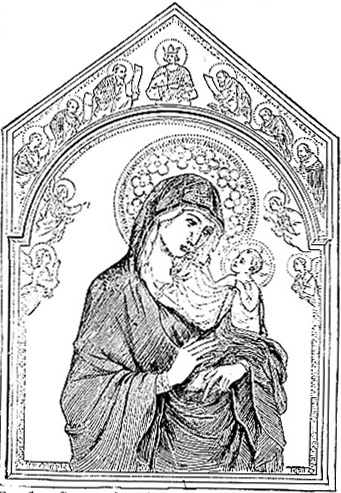1902 Encyclopedia > Schools of Painting > School of Siena (Italy)
Schools of Painting
(Part 3)
School of Siena (Italy)
No city, not even Florence, was so fertile as Siena in native painters during the 13th and 14th centuries. The earliest, working before 1300, did not emancipate themselves from the old Byzantine mannerism; Guido da Siena, Duccio (see fig. 1) and Segna di Buoninsegna possessed many of the peculiarities of the old school, -- its rigid attitudes, its thin stiff folds, and its greenish shadows in the flesh tints. In the first half of the 14th century a number of very able painters were carrying on at Siena a parallel development to that which Giotto had inaugurated at Florence; chief among the were Simone di Martino, Lippo Memmi, and especially Ambrogio Lorenzetti, a painter of both panels and large frescos, which show rich and noble imaginative power and much technical skill.

Fig. 1 -- Centre of a triptych, by Duccio di Buoninsegna, -- the Madonna with Angels, and, above, David and six Prophets. (National Gallery, London.)
It is important to note that Ambrogio and probably other painters of his time were, like the earlier Pisan Niccola, beginning to study the then rare examples of classical sculpture. Ghiberti, in his Commentary, speaks with enthusiasm of the beaty of an antique statue which he knew only from a drawing by Ambrogio Lorenzetti.
In the second half of the 14th century Siena produced a large number of more mediocre painters; but these were succeeded by an abler generation, among whom the chief were perhaps Sano di Pietro and Matteo di Giovanni, whose grand altarpiece (No. 1155), recently acquired, is one of the glories of the English National Gallery. Many excellent masters were working at Siena throughout the 15th century and even later; the last names of any real note are those of Peruzzi and Beccafumi. Sodoma, though he settled in Siena in 1501, does not belong to the school of Siena; his early life was passed at Milan, chiefly under the influence of Da Vinci. His talent was developed at Rome among the followers of Raphael.
Read the rest of this article:
Schools of Painting - Table of Contents
|
